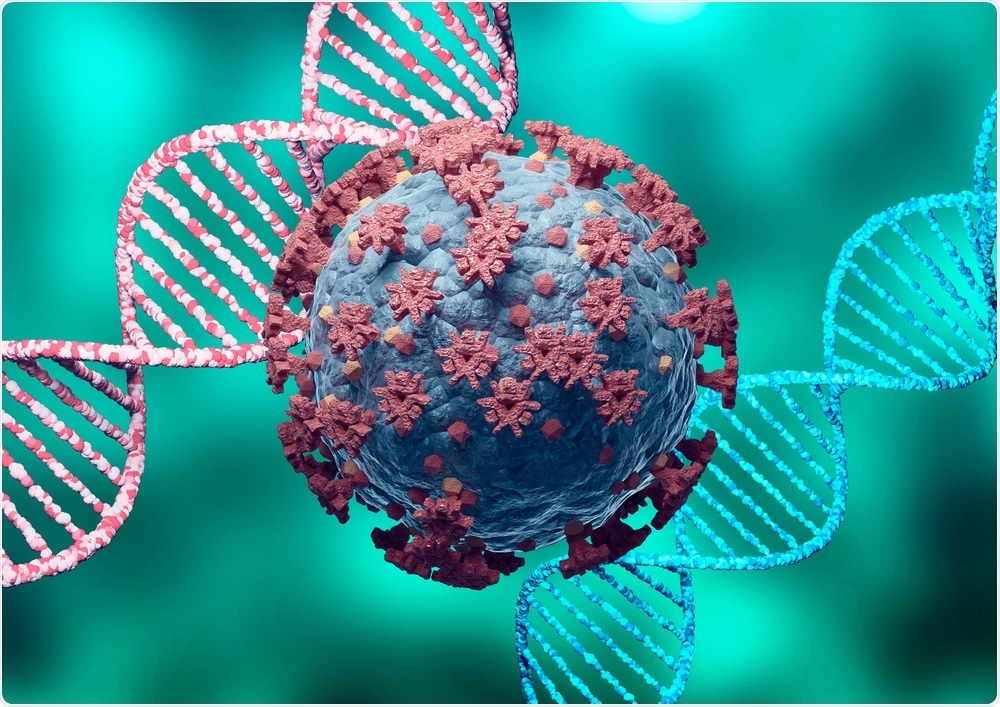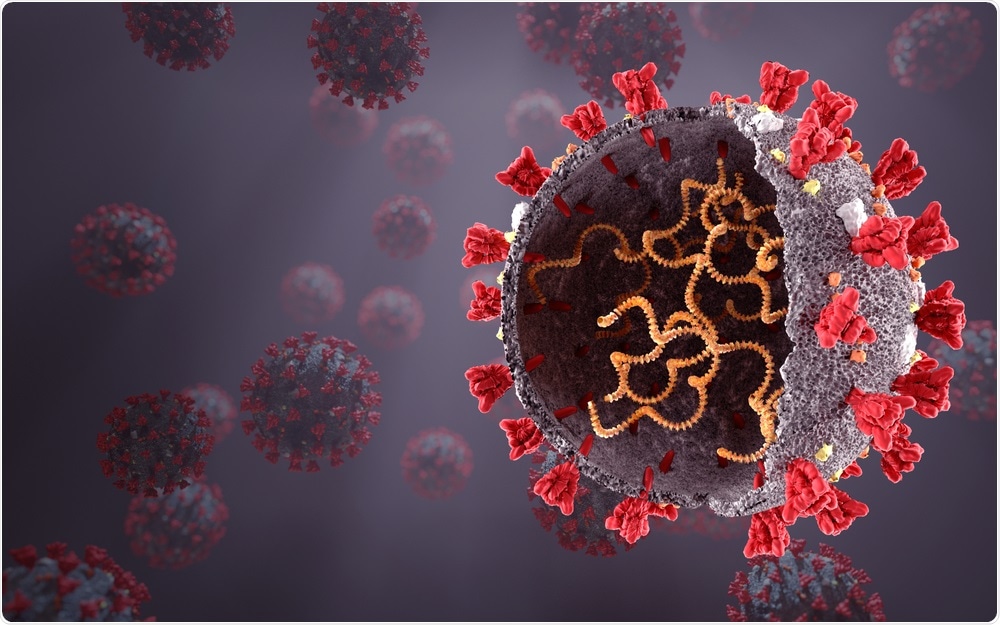Even as the coronavirus disease 2019 (COVID-19) pandemic shows signs of coming under control in some parts of the world following the achievement of a high level of population immunity, other countries are experiencing crushing rates of new infections and record numbers of deaths.
This increased infection rate has often been driven by new variants that are otherwise referred to as variants of concern (VOCs). VOCs are often more transmissible or have shown increased resistance to neutralization by antibodies elicited by infection of earlier variants or vaccine immunization.

A new medRxiv* preprint reports the immunomodulatory effect of the E484K mutation newly acquired by the United Kingdom (U.K.) variant. Also known as the B.1.1.7 (VOC-202012/01) variant, this mutated version of the severe acute respiratory syndrome coronavirus 2 (SARS-CoV-2), which is the virus responsible for COVID-19, has spread rapidly to over a hundred countries. In fact, the B.1.1.7 variant is considered to be the dominant strain circulating throughout many of these nations.
In February 2021, reports of the new VOC-202102/02 variant were published by Public Health England. While VOC-202102/02 exhibits the defining B.1.1.7 mutations, it has also acquired the E484K mutation. This E484K mutation has been identified in another immune-escape lineage of SARS-CoV-2 that is often referred to as the South African variant or B.1.351 strain.
The E484K mutation is in the receptor-binding domain (RBD) of the viral spike (S) glycoprotein, which mediates virus-host cell receptor attachment and viral entry into the host cell.
Study aim
The current study aimed to explore whether the presence of this additional mutation confers immune evasion capabilities from the parent B.1.1.7 variant. The researchers examined the genes that were active in the form of transcribed ribonucleic acid (RNA) molecules in 40 hospitalized patients. Of these patients, 12 were infected with the newer SARS-CoV-2 variants, whereas the remaining 28 patients were infected with the parent U.K. variant.
Over 3,000 genes were found to be significantly higher within five days of the onset of symptoms. These genes were part of various immune response pathways, including the interleukin-Janus kinase (IL-JAK)/ signal transducer and activator of transcription (STAT) signaling as well as interferon responses. Both the IL-JAK/STAT pathway and interferon responses are concerned with innate immunity and the primary antiviral response.
Inflammatory responses to B.1.1.7
Within the first five days of symptom onset, the researchers of the current study found that individuals infected with the B.1.1.7 strain exhibited a higher number of differentially expressed genes (DEGs) as compared to those infected with the parent U.K. variant.
Patients in the VOC-202102/02-infected group showed relatively higher activation of the JAK/STAT and interferon pathways. Thus, the E484K mutation appears to change the profile of the immune response as compared to that which arises following infection by the original B.1.1.7 variant.
Over the first five days from symptom onset, approximately 300 genes were more highly expressed in the VOC-202102/02 group. From days 10-14, their expression diminished, but less steeply in the VOC-202102/02 group.
Overall, the response more sustained in the VOC-202102/02 group. Additionally, two-thirds of the highly expressed genes were mediated by cytokine-responsive JAK/STAT signaling pathways and interferon pathways.
Effect of vaccination
Vaccinated patients who had at least one dose of the messenger RNA (mRNA) vaccine before developing COVID-19 symptoms were also included in the study. Among these individuals, those infected with the VOC-202102/02 variant after vaccination exhibited 19 fewer expressed genes as compared to unvaccinated infected patients.
The genes that were found to exhibit reduced expression in vaccinated individuals included those that are involved in the interferon, JAK/STAT, and tumor necrosis factor α (TNF-α) pathways.
Differences with other strains
Gene expression also varied substantially between those infected with the parent U.K. variant and those infected with the VOC-202102/02 variant after receiving one or more doses of the vaccine.
Within the first five days, interferon responses were higher in those infected with the U.K. variant when compared to the B.1.1.163 or B.1.258 variants. Moreover, these interferon responses were found to trigger greater JAK/STAT signaling and increased inflammatory activation.
Patients who were infected by either the parent variant or the VOC-202102/02 showed the highest expression of important interferon-stimulated genes (ISGs), relative to the other variants.
 Image Credit: Orpheus FX / Shutterstock.com
Image Credit: Orpheus FX / Shutterstock.com
What are the implications?
The host response to SARS-CoV-2 is fast to emerge and typically arises within five days of symptom onset; however, the immune response appears to drop steeply by day 14. Within four weeks, the immune response to the infection decreases further, though not to normal levels.
These findings agree with earlier work published by the researchers of this study, wherein asymptomatic or mild SARS-CoV-2 infection failed to produce any difference in gene expression as compared to healthy controls from the same region. In other words, the time of collection of transcriptome samples in relation to the time of the infection is an important parameter for correctly assessing these samples of people infected by either B.1.1.7 or B.1.1.7+E484K.
Deaths were comparable in either group, with all deaths occurring in elderly people with a history of chronic medical conditions. No specific predictors were found in terms of active genes between non-survivors and survivors.
Even one dose of the vaccine led to alterations in the transcriptome but did not reduce disease severity. However, the transcribed genes continued to show differences depending on whether the parent U.K. strain or the E484K-positive variant was the infecting strain, independent of vaccination history. In fact, many infections, some serious, and several deaths have been reported after one dose of the vaccine.
Overall, the researchers determined that “the E484K mutation is sufficient to alter transcriptome response.“ This escape mutation can emerge rapidly within just ten days following infection, a phenomenon that was recorded in one immunocompromised patient. The differences in the activated genes were not obviously reflected in clinical differences, perhaps because all patients were already hospitalized.
It is important to understand why different variants elicit differences in the host immune response, both innate and adaptive. This could help design potent vaccines and antibodies with a broader breadth of S protein antigen coverage to help tackle the increasing diversity of SARS-CoV-2 infection.
*Important notice
medRxiv publishes preliminary scientific reports that are not peer-reviewed and, therefore, should not be regarded as conclusive, guide clinical practice/health-related behavior, or treated as established information.
- Lee, H. K., Knabl, L., Knabl Sr., L., et al. (2021). Immune transcriptomes from hospitalized patients infected with the SARS-CoV-2 variants B.1.1.7 and B.1.1.7 carrying the E484K escape mutation. medRxiv preprint. doi:10.1101/2021.05.27.21257952. https://www.medrxiv.org/content/10.1101/2021.05.27.21257952v1
Posted in: Medical Science News | Medical Research News | Disease/Infection News
Tags: Antibodies, Antigen, Cell, Chronic, Coronavirus, Coronavirus Disease COVID-19, Cytokine, Gene, Gene Expression, Genes, Glycoprotein, Immune Response, Immunization, Immunomodulatory, Kinase, Mutation, Necrosis, Pandemic, Protein, Public Health, Receptor, Respiratory, Ribonucleic Acid, RNA, SARS, SARS-CoV-2, Severe Acute Respiratory, Severe Acute Respiratory Syndrome, Syndrome, Transcription, Tumor, Vaccine, Virus

Written by
Dr. Liji Thomas
Dr. Liji Thomas is an OB-GYN, who graduated from the Government Medical College, University of Calicut, Kerala, in 2001. Liji practiced as a full-time consultant in obstetrics/gynecology in a private hospital for a few years following her graduation. She has counseled hundreds of patients facing issues from pregnancy-related problems and infertility, and has been in charge of over 2,000 deliveries, striving always to achieve a normal delivery rather than operative.
Source: Read Full Article
